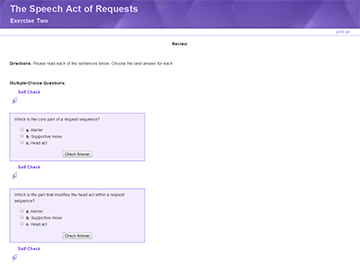Unit 2: How to Make a Request in Chinese
Unit 2 explicitly teaches students the sequence that requests in Chinese follow and different parts within a request sequence. In addition, this unit offers students corresponding exercises to practice.
1.1 Goal of Unit 2
The goal of Unit 2 is to familiarize students with different parts included within a request sequence in Chinese and to provide them with more examples of request making in both American English and Chinese. After studying this unit, students are expected to be able to identify different components of a request expression.
2.2 Request Sequence
Similar to request making in English, a request in Chinese follows certain sequence. Learning about the request sequence is helpful for learning to make a request in Chinese.
Previous studies on requests have identified that a request sequence may include: alerters (e.g., address terms), pre-supportive moves, the head act, and post-supportive moves. Alerters and pre- and post-supportive moves are optional. First, we look at a request example in English:
Judith, I missed class yesterday, do you think I could borrow your notes? I promise to return them by tomorrow . (Blum-Kulka et al., 1989, p. 17)
In this example, Judith is the alerter, attracting the hearer’s attention; do you think I could borrow your notes is the head act, the minimal unit that can realize a request and the core part of the sequence. A supportive move is a unit that modifies the head act, positioned either before or after the head act. As in the example, I missed class yesterday is the pre-supportive move, while I promise to return them by tomorrow is the post-supportive move.
Now let’s look at one example in Chinese:
老师,您现在有空吗?我想问您一个问题。谢谢。
Lǎoshī, nín xiànzài yǒukòng ma? Wǒ xiǎng wèn nín yí gè wènti. Xièxiè.
Thinking: What are the alerter, supportive move, and head act of this request?
Answer:
老师,您现在有空吗?我想问您一个问题。谢谢。

To learn more about the Chinese words and expressions in this section, please refer to the Glossary below.
| Word | Pinyin | Part of speech | English translations |
| 老师 | lǎoshī | noun | Teacher; professor |
| 您 | nín | pronoun | You (polite form) |
| 现在 | xiàn zài | adv. | Now; at present |
| 有空 | yǒu kòng | N/A | Have time; at leisure |
| 我 | wǒ | pronoun | I; me |
| 想 | xiǎng | verb | To think; want |
| 问 | wèn | verb | To ask |
| 一 | yī | number | One |
| 个 | gè | measure word | A common measure word |
| 问题 | wèn tí | noun | Question; problem |
| 谢谢 | xièxiè | verb | Thanks; thank you |
Review
Please click on the Review link to access this Exercise Two.
